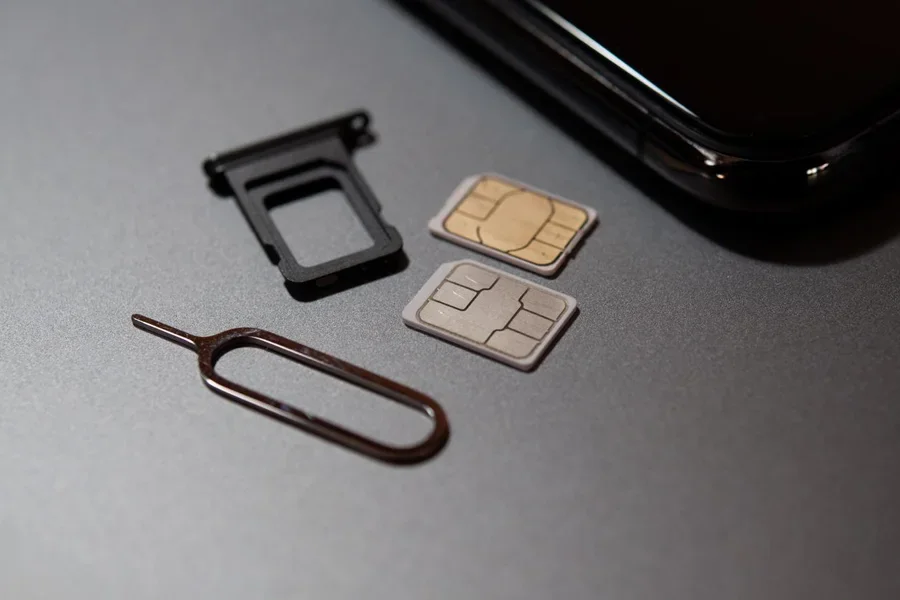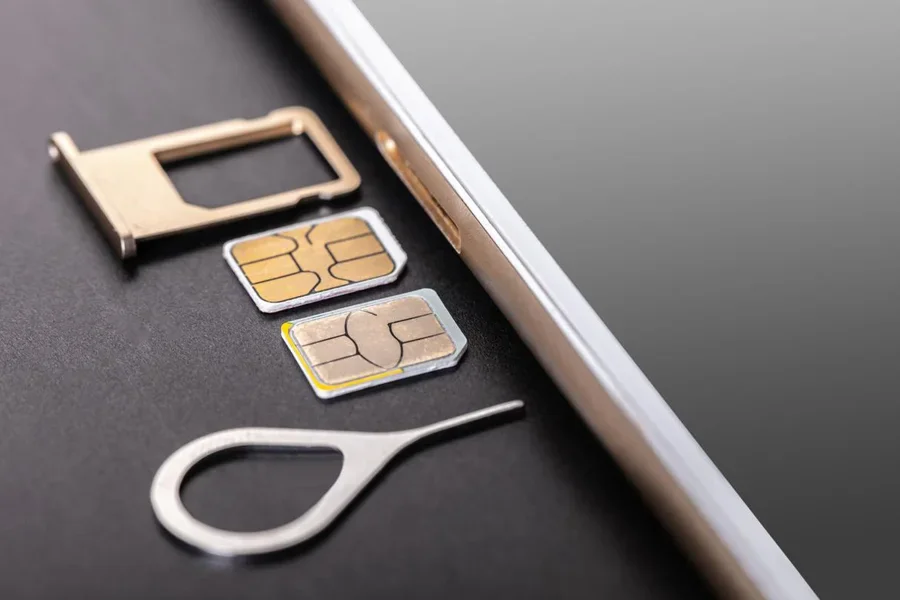Table of Contents
1. Introduction
2. Exploring SIM Card Types and Their Unique Uses
3. SIM Card Market Trends in 2025
4. Key Considerations When Selecting a SIM Card
5. Top SIM Card Options and Their Features
6. Conclusion
Introduction
The evolution of mobile phone SIM cards has shifted from traditional physical chips to digital eSIMs, transforming connectivity options across devices. Physical SIM cards remain widely accessible, enabling users to change providers by swapping cards easily. In contrast, eSIMs are embedded directly into devices, providing remote activation, greater security, and enabling thinner, sleeker phone designs. Specialized options like prepaid SIMs cater to short-term needs, offering flexibility without contracts. These varied SIM card formats ensure adaptable connectivity solutions, meeting diverse demands for secure, on-the-go communication.
Exploring SIM card types and their unique uses

Overview of physical SIM cards and their accessibility
Physical SIM cards, the traditional format, remain widely used and are valued for their simplicity. They are easy to remove and swap between devices, making them ideal for people who frequently change phones or use multiple networks. Globally supported, physical SIMs allow users to switch to local networks when traveling, helping avoid roaming charges and ensuring strong connectivity. This broad compatibility across devices and networks keeps them relevant even as newer technologies emerge.
eSIM technology and its integration in modern devices
The eSIM, or embedded SIM, is a digital SIM technology directly integrated into the device. Unlike physical cards, eSIMs allow for remote activation of mobile service through a digital profile, saving space within the device and supporting slimmer, more efficient designs. eSIMs are beneficial for users who need flexibility, as they allow for dual-SIM capabilities; one device can manage two numbers or carriers without needing a physical slot. Additionally, eSIMs offer enhanced security since they cannot be easily removed, which protects user data and reduces the risk of loss. However, eSIM compatibility still depends on the device and carrier, though more options are emerging to support this technology.
Specialized prepaid SIM cards for travel and data-only needs
Prepaid SIM cards offer a flexible, commitment-free solution ideal for short-term use. These cards allow users to prepay for a set amount of data, calls, or texts, making them cost-effective for travelers or devices with specific data requirements, like tablets or IoT devices. Leading providers such as T-Mobile and AT&T offer prepaid plans that are well-suited for short-term needs, offering the benefit of local connectivity without binding contracts. This approach ensures that prepaid SIMs provide practical, temporary options for users looking to control costs while staying connected.
SIM card market trends in 2025

Rise of eSIM Technology
In 2025, eSIM technology is reshaping mobile connectivity across smartphones, IoT devices, and automotive applications. By 2024, eSIM-enabled devices had reached over 3.4 billion globally, marking a major shift toward digital SIMs. This shift is driven by the advantages eSIM offers, such as simplified carrier switching, enhanced security, and efficient space usage—benefits crucial to high-connectivity applications like smart cities, industrial IoT, and connected vehicles. With the global eSIM market projected to grow from approximately USD 8.34 billion in 2024 to around USD 19.35 billion by 2031 at a CAGR of 10.5%, this technology’s adoption is expected to continue its upward trajectory. Major smartphone manufacturers like Apple and Samsung are accelerating this trend by embedding eSIM functionality in their devices, supporting a multi-network, seamless experience that aligns with user expectations for flexible, reliable connectivity, according to Straits Research.
Shifts in consumer demand toward seamless connectivity
Consumer expectations for seamless connectivity are transforming the SIM card market, much like the evolution seen in high-demand technologies like satellite TV receivers. As users increasingly seek uninterrupted mobile experiences that support multiple networks on a single device, technologies like dual-SIM and eSIM have become essential. The adoption of eSIM and dual-SIM capabilities enables devices to switch between networks without requiring physical SIM swaps, offering versatile connectivity that supports various user scenarios. Combined with the global rollout of high-speed 5G, this shift positions the SIM card industry to keep pace with growing demand for reliable, customizable, and secure mobile connections worldwide.
Key considerations when selecting a SIM card

Compatibility with devices and network support
When choosing a SIM card, ensuring compatibility with both the device and network technology is crucial. Devices vary widely in the SIM formats they support, such as nano, micro, or standard SIMs, and newer devices may be designed solely for eSIMs. Compatibility with network technology (like 4G or 5G) is also essential to leverage the device’s full potential. For example, eSIM technology is increasingly popular and advantageous for multi-network support, but not all carriers or regions fully support it yet, so verifying carrier compatibility beforehand is critical. This is particularly true for global connectivity needs, where network band compatibility may affect connectivity abroad.
Data allowance and international coverage options
Data allowances and international roaming options are fundamental considerations for those who need frequent connectivity across regions. For international usage, some SIM cards offer extensive roaming networks and customizable packages that provide a cost-effective way to manage data usage outside domestic networks. Roaming features vary by provider, with options like data add-ons or country-specific plans to maintain connection quality and manage costs. Reviewing these options helps avoid unexpected roaming charges and ensures smooth connectivity in frequently visited areas, essential for businesses requiring global access or data-reliant applications.
Security features and privacy protections
Security remains a top priority when selecting SIM cards, especially for eSIMs and traditional physical SIMs alike. Physical SIMs benefit from security features like PIN protection and secure storage, while eSIMs inherently reduce physical risks since they are embedded within the device, adding an extra layer of security. For both types, additional protective measures such as two-factor authentication, regular monitoring for unusual activity, and secure provider networks can help guard against SIM swapping and other vulnerabilities. eSIM technology also allows remote management and reprogramming, making it more adaptable for secure enterprise needs or IoT applications. Prioritizing a SIM card provider with robust security protocols can greatly reduce risks associated with unauthorized access and data breaches.
Top SIM card options and their features

Leading physical SIM and eSIM options
In the evolving mobile connectivity landscape, both physical SIMs and eSIMs provide distinct advantages. Physical SIMs are still widely supported and allow easy swapping between devices, making them practical for flexible network access across different regions. In contrast, eSIM technology offers a digital alternative embedded directly within devices, providing additional security and space-saving benefits. Users can remotely activate and switch networks without handling a physical card, making eSIMs particularly suitable for frequent travelers or professionals managing multiple numbers on a single device. Dual-SIM capabilities are another feature of eSIMs, allowing users to maintain separate numbers for different purposes, such as personal and business lines, without needing multiple devices.
Highlighting top prepaid SIM cards for specific needs
Prepaid SIM cards continue to be a practical choice, especially for those looking for flexibility and cost control without a long-term commitment. These options generally provide a range of data allowances and allow for straightforward budget management, making them well-suited for short-term needs or data-only requirements in devices like tablets and IoT gadgets. Prepaid SIMs typically offer add-ons for international roaming, allowing users to maintain connectivity without incurring high fees associated with standard plans. They are particularly appealing to those who require occasional access or have data-light usage patterns.
Conclusion
Choosing the right SIM card is essential to achieving secure, reliable, and adaptable connectivity, especially as technology progresses. From traditional physical SIM cards to advanced eSIM options, each type offers specific advantages depending on connectivity needs, device compatibility, and security requirements. Prepaid SIMs add flexibility for short-term use or budget-conscious applications, while eSIM technology supports seamless switching between networks and enhances security for those needing consistent international access. With these diverse options, selecting a SIM card tailored to specific demands enables efficient, scalable connectivity across today’s dynamic mobile environments.



